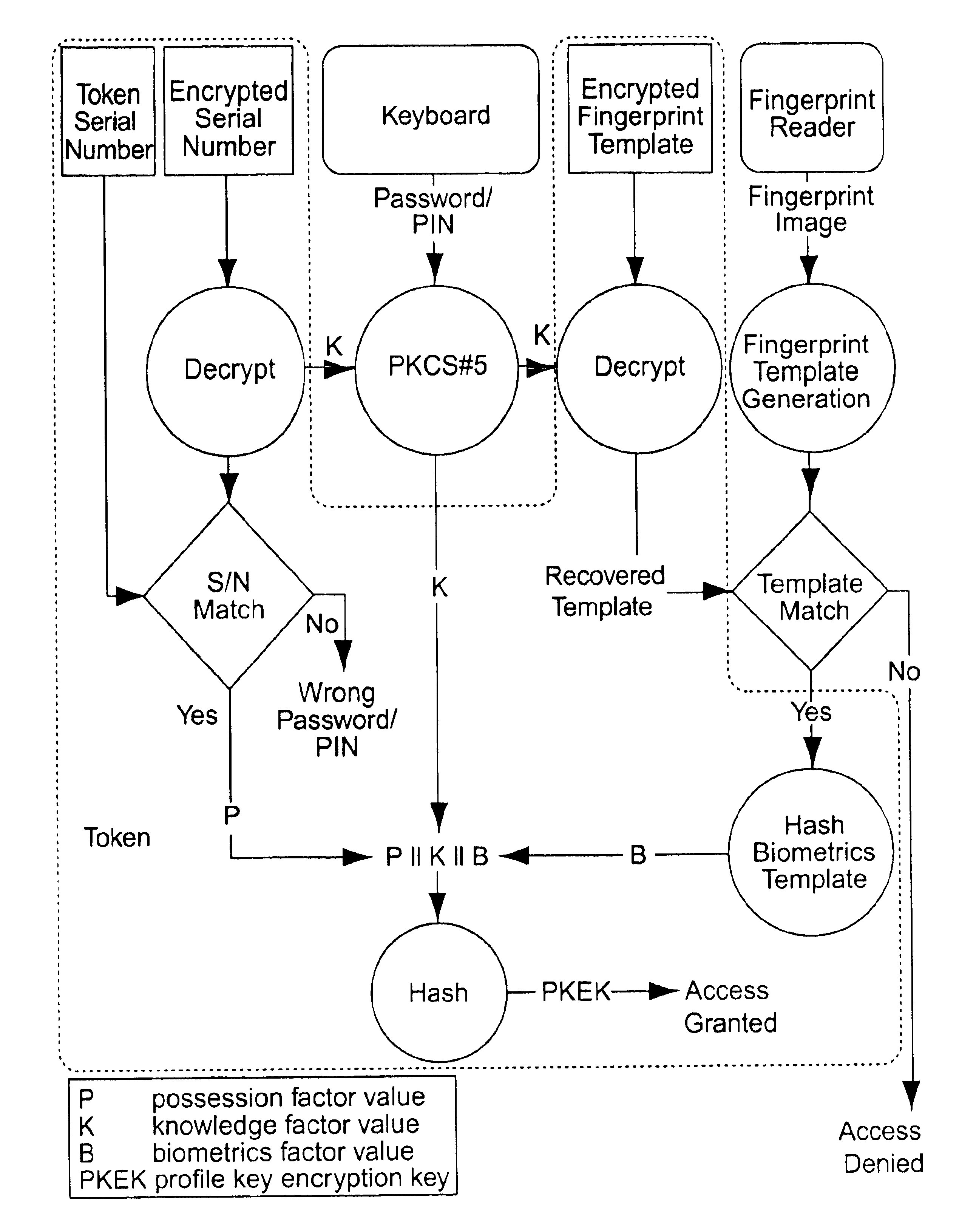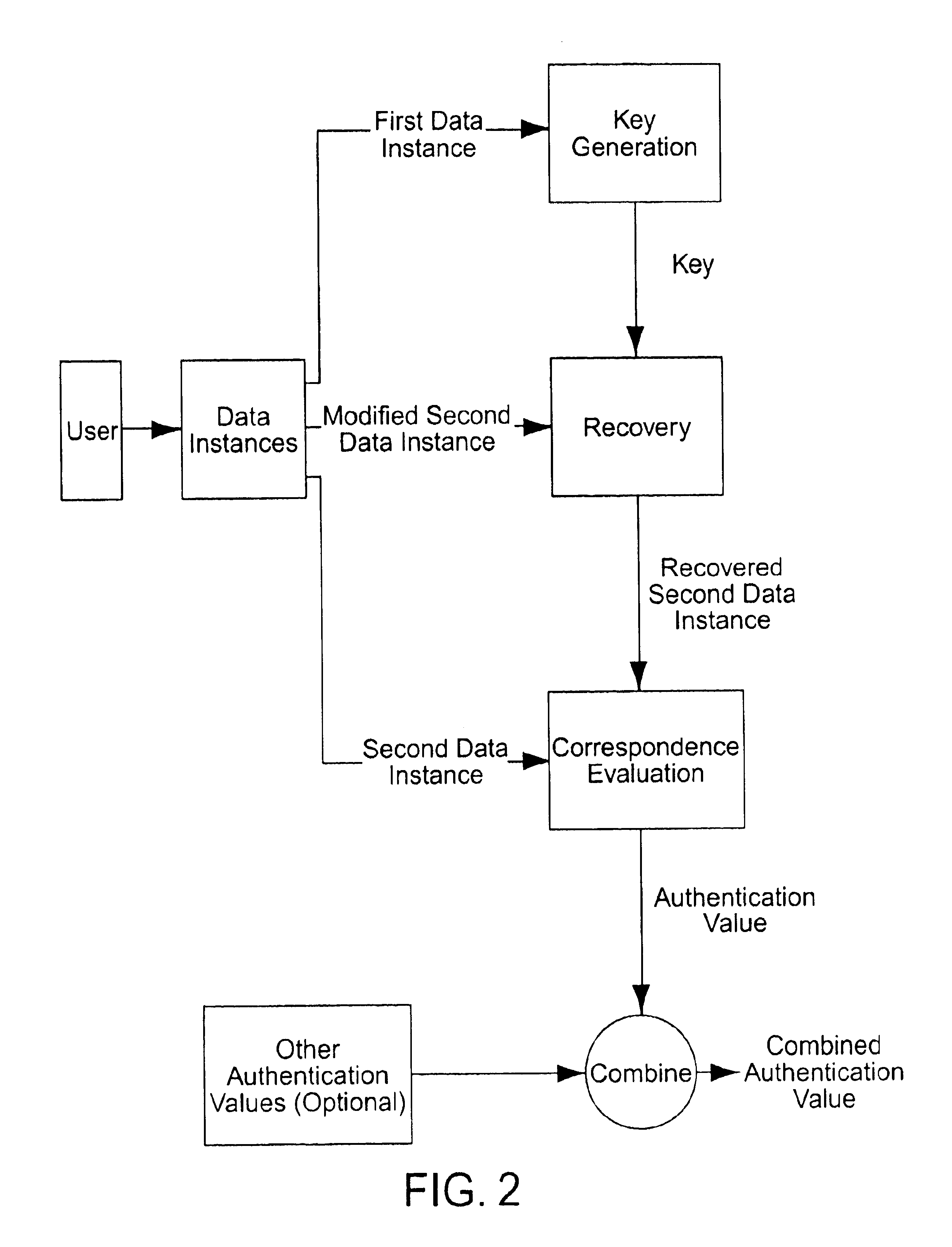Multiple factor-based user identification and authentication
a multi-factor authentication and user identification technology, applied in the field of multi-factor authentication, can solve the problems of reducing complexity, unacceptably high false negative rate, and inherent problems of most knowledge-based authentication protocols
- Summary
- Abstract
- Description
- Claims
- Application Information
AI Technical Summary
Problems solved by technology
Method used
Image
Examples
first exemplary embodiment
As shown in FIG. 3, a first exemplary identification process of the present invention includes knowledge-based, possession-based, and biometric-based factors. In this particular embodiment, these factors take the form of a password / PIN, a token, and a fingerprint reading, respectively. The identification process for a session proceeds as follows.
The user provides a token and a password, either in response to a prompt or unprompted to begin a session. A system algorithm, such as PKCS#5, is used to create a key value, K, from the password. The key K is used to decrypt the encrypted token serial number that is stored on the token. Alternatively, an encrypted member ID, stored on the token, is used as a password check. The decrypted value is compared against the plaintext serial number or the entered member ID. If the two values match or otherwise correspond in a predetermined manner, it is determined that the password has been entered correctly. If there is no correspondence, it is det...
second exemplary embodiment
As shown in FIG. 4, a second exemplary identification process of the present invention includes knowledge-based and biometric-based factors. In this particular embodiment, these factors take the form of a password / PIN and a fingerprint reading, respectively. The identification process for a session proceeds as follows.
The user provides a token, either in response to a prompt or unprompted to begin a session. The token stores a serial number, P, which is used as an input to the PKEK derivation process.
During enrollment, a biometrics template is created for fingerprint verification according to this exemplary embodiment; in other, similar, embodiments, an alternative or additional biometric instance can be utilized. If plain fingerprint template matching is being used, the enrollment template resides on the token. If a Bioscrypt™ or similar system, as previously described, is used instead, this template is stored on the token. The user inserts a finger in a fingerprint reader at the i...
third exemplary embodiment
As shown in FIG. 5, a third exemplary identification process of the present invention includes knowledge-based and biometric-based factors. This process is similar to that of the previous embodiment; here the fingerprint template is stored in encrypted form on the token, using the token serial number as the key. The token will first decrypt the template before template matching takes place.
In this particular embodiment, these factors take the form of a password / PIN and a fingerprint reading, respectively. The identification process for a session proceeds as follows.
The user provides a token, either in response to a prompt or unprompted to begin a session. The token stores a serial number, P, which is used as an input to the PKEK derivation process.
During enrollment, a biometrics template is created for fingerprint verification according to this exemplary embodiment; in other, similar, embodiments, an alternative or additional biometric instance can be utilized. The template is prote...
PUM
 Login to View More
Login to View More Abstract
Description
Claims
Application Information
 Login to View More
Login to View More - R&D
- Intellectual Property
- Life Sciences
- Materials
- Tech Scout
- Unparalleled Data Quality
- Higher Quality Content
- 60% Fewer Hallucinations
Browse by: Latest US Patents, China's latest patents, Technical Efficacy Thesaurus, Application Domain, Technology Topic, Popular Technical Reports.
© 2025 PatSnap. All rights reserved.Legal|Privacy policy|Modern Slavery Act Transparency Statement|Sitemap|About US| Contact US: help@patsnap.com



